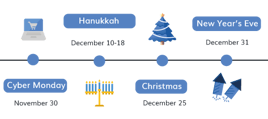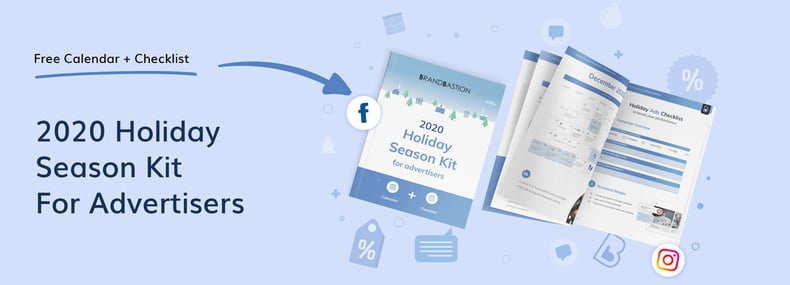
Holiday Advertising 2020: What You Need To Know (+ Free Kit)
In the e-commerce industry, holiday sales, on average, account for 30% of sales for the entire year. Perhaps unsurprisingly, the biggest sales occur in the Fall, due to Black Friday, Cyber Monday, Christmas, and New Year. Because of this, experienced marketers usually start planning their holiday advertising strategies several months in advance.
| Bonus: To help you stay organized this year, we created an Advertisers Kit for this Holiday Season. |
As Q4 approaches this year, advertisers will be facing additional challenges due to major changes in consumer behavior since the outbreak of COVID-19. One of the biggest challenges for advertisers this holiday season will be adjusting their strategies to meet the latest customer expectations in these uncertain times.


Reports show that consumers expect to increase spending during November and December by 22% and 40% respectively, presenting a great opportunity for brands to boost sales after a challenging start to the year.
Advertisers should therefore see this as an opportunity to engage with their customers and to evaluate their current needs. As a starting point, brands should listen to the conversations taking place across their ads and ask themselves questions such as;
- What do our customers want right now?
- What are our customers’ key concerns and expectations?
- How do we communicate best with them?
At BrandBastion, we believe that brand presence and advertising on social media will be more important than ever to create meaningful engagement with customers during the busy holiday season.
Our team suggests the following key strategies to stay on top of the game:
Plan and start advertising sooner
According to a study conducted by Voxware, 51% of respondents expect to begin their holiday shopping earlier this year. Many consumers fear lockdowns and second waves of the pandemic and are therefore already now starting their holiday shopping.
Marketers who wait until Black Friday or Cyber Monday to share their ads and promotions will likely be missing early buyers.
Holiday shoppers will lean on e-commerce
According to a recent Google report, the traditionally heavy online-shopping holiday season is expected to grow even bigger and increase in demand due to increased engagement on online platforms during the first half of 2020.

In fact, the report predicts that almost 70% of U.S. consumers are planning on making more purchases online than they have previously. According to Adobe, the pandemic has accelerated the growth of e-commerce by four to six years, making online shopping even bigger than it was during the holiday season in 2019.
Assume that customers have higher expectations than before
In the last few months, the average time spent scrolling, searching, and comparing content on the internet and social media has increased significantly. As a result, consumers today are more educated about brands’ products and services due to instantly available reviews and opinions online.
More than ever before, customers expect brands to be proactive and responsive while maintaining recommended health and safety regulations on their products and services.
Brands should closely follow what users are saying about their products on their ads to identify issues and concerns so these can be addressed in time. By keeping track of reactions to your social media posts and ads by using listening tools, you can evaluate sentiment and identify customer concerns about a certain product, service, or promotion.
Follow the conversation and engage with customers
It’s not uncommon for heated discussions to take place online, making social media a busy and unpredictable place. We recommend that your brand decides ahead of time how you want to deal with potential debates that might take place in your comment sections, especially as we’re approaching the US elections.
For brands, every unanswered customer inquiry could result in a chain reaction of negative comments about the brand and result in potential customers rethinking their purchase. That said, ads and organic posts on social media are already likely to receive a large amount of engagement during the holiday season.
Create clear community guidelines for your social media channels, and make sure everyone sticks to them. Implement processes to respond to feedback and ensure that your customers’ questions, complaints, and overall engagement are being answered and attended to.
Consumers will expect more engagement from brands this holiday season and prioritize the brands that go the extra mile in being communicative. Therefore, every engagement and interaction with customers will count, improving brand loyalty. Above all, social media advertising should be a two-way communication between the brand and consumer.
|
Bonus: Prepare for the upcoming Quarter 4 holidays by building a social strategy that addresses consumers’ heightened expectations. BrandBastion’s new Holiday Kit will help you plan, prepare, and execute your marketing campaigns during the busy holiday season. BrandBastion helps top advertisers such as Netflix, Uber, and HelloFresh drive better conversations on social media, whilst protecting their brand. 
|